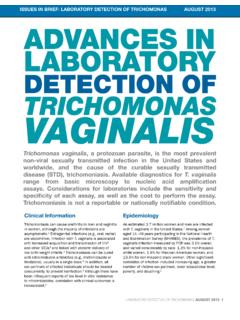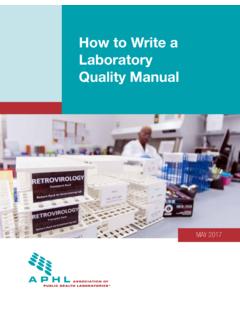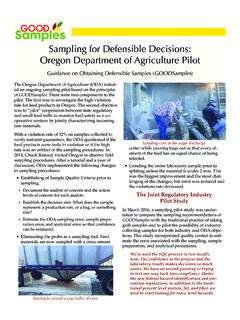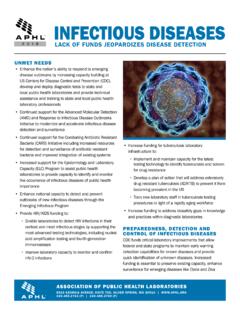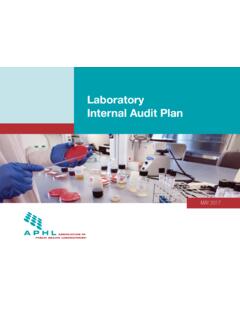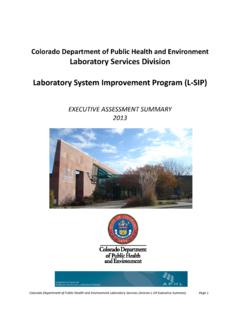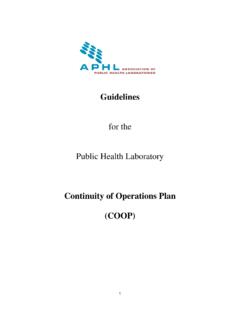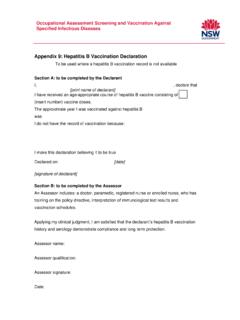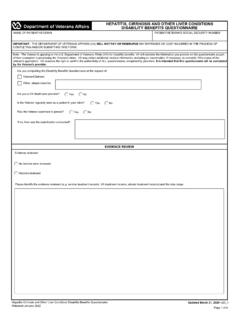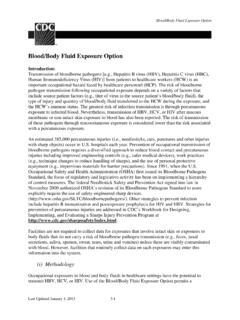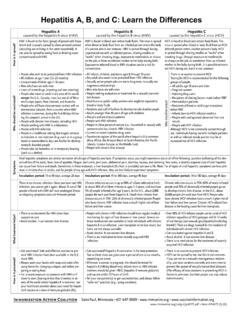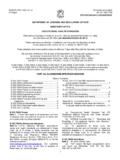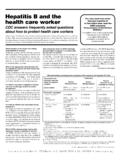Transcription of Interpretation of Hepatitis C Test Results: Guidance for ...
1 APHL HCV Test Result Interpretation Guide | 1 LABORATORY MARKERS OF HCV INFECTIONC urrently available Hepatitis C Virus (HCV) antibody tests have a window period from exposure to HCV to detection of antibody of approximately 8-11 weeks. Nucleic acid amplification tests (NAT) can detect HCV RNA approximately 1-2 weeks after exposure. This means that for the first eight weeks following exposure to HCV antibody tests may not be able to detect HCV antibodies, and for the first 1-2 weeks following HCV exposure NATs may not be able to detect HCV 1: Laboratory Markers of HCV Infection (provided by S.)
2 Kamili, DVH, CDC)ALL HCV ANTIBODY POSITIVE results REQUIRE SUPPLEMENTAL RNA TESTING Since 2013, the US Centers for Disease Control and Prevention (CDC) recommends that all specimens that are HCV antibody reactive should be tested using a NAT to detect HCV RNA in order to confirm current HCV infection. To ensure all patients receive the recommended testing, the preferred practice is for laboratories to reflex all HCV antibody reactive specimens directly to NAT for HCV RNA. The 2013 recommendations supersede previous recommendations to report anti-HCV positive results only after applying assay-specific signal-to-cutoff (S/CO) thresholds or confirmation with the Recombinant ImmunoBlot Assay (RIBA), which is no longer available.
3 S/CO ratios for HCV antibody testing are no longer recommended for: 1. determining which samples require additional testing2. reporting of results to either healthcare providers or health department surveillance programs. While reporting S/CO is not recommended, some health departments may still require reporting of S/CO and laboratories should confirm reporting requirements with the jurisdictional health department. However, all HCV antibody-reactive results should be followed with HCV RNA testing, irrespective of the local jurisdiction s reporting requirements.
4 Interpretation of Hepatitis C Virus Test results : Guidance for LaboratoriesINFECTIOUS DISEASESJANUARY 2019 APHL HCV Test Result Interpretation Guide | 2 REPORTING DETECTABLE NOT QUANTIFIABLE results Quantitative NATs measure the amount of viral nucleic acid (RNA or DNA) in the blood. Each FDA-approved NAT for quantitation of HCV RNA has a limit of detection (LoD), a lower limit of quantitation (LLoQ), and an upper limit of quantitation (ULoQ) (Figure 2, Table 1). All of these measures can vary by assay. Please refer to the package insert for the specific values and reporting language that applies to each assay.
5 For your convenience, we have summarized the commonly used assays and values in Table 1 but the most updated information should be obtained from the manufacturer. The LoD represents the lowest concentration that HCV RNA can be detected The LLoQ represents the lowest concentration that HCV RNA can be accurately quantified For some quantitative HCV RNA assays, the LoD and LLoQ are the same concentration. For others, the LLoQ is a higher concentration than the LoD and it is possible for the assay to detect HCV RNA but not quantify the amount present in the specimen.
6 When the concentration of HCV RNA detected in a sample is above the LoD and below the LLoQ, the result is detectable but not quantifiable (Figure 2 (Yellow Box), Table 1,). The appropriate language to report this result varies by assay and is available in the package insert. Reporting this result as HCV RNA negative or not detectable is inaccurate and misleading. Provision of accurate results is essential to preventing transmission of the virus and to support clinical 2: LoD, LLoQ and ULoQ Related to HCV RNA Concentration BEST PRACTICES FOR REPEAT HCV TESTING There are certain scenarios where repeat HCV testing should be considered per CDC recommendations and the American Association for the Study of Liver Diseases in collaboration with the Infectious Disease Society of America.
7 For persons who had a negative HCV antibody result and a potential HCV exposure within the past six months, testing for HCV RNA or follow-up testing for HCV antibody is recommended. For persons who had a negative HCV antibody result and are immunocompromised or have liver disease, testing for HCV RNA can be considered. APHL HCV Test Result Interpretation Guide | 3 For persons with a positive HCV antibody result and negative HCV RNA result, HCV RNA testing should be repeated if:o a potential HCV exposure occurred within the past six months. o clinical evidence of HCV infection is present.
8 O there are concerns regarding specimen integrity including handling and storage conditions that may have compromised test results . For persons with a positive HCV antibody result and a HCV RNA result that is detectable but too low to be quantified repeat HCV RNA testing should be considered. o A low-positive HCV RNA result may occur for a number of reasons and collection of a follow-up specimen in 2-4 weeks for repeat testing should be considered. Table 1: Currently Available FDA-Approved HCV Qualitative and Quantitative RNA TestsManufacturer (PMA #)DeviceaLoDb SerumLoDb PlasmaLLoQc (serum or plasma)ULoQd (serum or plasma)Abbott Molecular (P00017)Abbott RealTime log10 IU/mL log10 IU/mL log10 IU/mL IU/mL8 log10 IU/ml 100,000,000 IU/mLHologic (P020011)Aptima HCV Qual Dx Assay IU/mLN/A Qualitative AssayN/A Qualitative AssayHologic (P160023)Aptima HCV Quant Dx log10 IU/mL log10 IU/mL log10 IU/ml IU/mL8 log10 IU/ml 100,000,000 IU/mLRoche Molecular (P150015)
9 Cobas-HCV (for 6800/8800) IU/mL100,000,000 IU/mLRoche Molecular (P060030)eCOBAS Ampliprep/COBAS Taqman HCV IU/mL100,000,000 IU/mLa. Package Inserts are provided for reference use only. For the most updated version please either login to your account with the manufacturer, review the package insert with the assay that was included with the version that is currently being run, or contact a sales representative. b LoD as assessed with the WHO international standard for HCV RNA (Genotype 1a); LoDs can vary for other HCV genotypes. c. Roche Molecular uses the term Titer Min instead of Lower limit of Quantificationd.
10 Roche Molecular uses the term Titer Max instead of Upper Limit of Quantificatione. P060030 was originally approved on 10/30/2008 for the quantitation of HCV RNA in patients undergoing anti-HCV treatment; the diagnostic claim was validated and submitted to FDA as a PMA supplement and was approved on 02/18/2016. Association of Public Health Laboratories The Association of Public Health Laboratories (APHL) works to strengthen laboratory systems serving the public s health in the US and globally. APHL s member laboratories protect the public s health by monitoring and detecting infectious and foodborne diseases, environmental contaminants, terrorist agents, genetic disorders in newborns and other diverse health project was 100% funded with federal funds from a federal program of $223,385.
